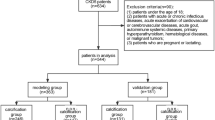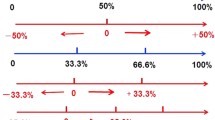Abstract
Purpose
The risk factors of chronic kidney disease were analyzed by using the region of interest quantitative technology of color Doppler combined with QLab software, and a Nomogram was established to conduct an individualized assessment of patients with chronic kidney disease.
Methods
A total of 500 patients with chronic kidney disease diagnosed in our hospital from June 2019 to March 2021 were selected as the chronic kidney disease group, and 300 healthy patients during the same period were selected as the control group. Univariate analysis was performed on the test indexes and the vascularity index, flow index, and vascularization flow index measured by the color doppler region of interest quantitative technique. The above meaningful indicators were included in the Logistics regression analysis to obtain the independent risk factors of early chronic kidney disease. The independent risk factors were imported into R software to draw a Nomogram model for predicting early chronic kidney disease and evaluate the model.
Results
Single factor analysis results suggest age, hypertension, diabetes, hyperlipidemia, disease of heart head blood-vessel, body mass index, vascularity index, flow index, and vascularization flow index, fasting blood sugar, triglyceride, total cholesterol, urea nitrogen, creatinine, uric acid, glomerular filtration rate differences statistically significant (P < 0.05). Logistics regression analysis showed that hypertension, diabetes, flow index, and vascularization flow index, urea nitrogen, and albumin were independent risk factors for the early occurrence of chronic kidney disease. The C-index of this Nomogram using independent risk factors is 0.896 (95%CI 0.862–0.930), which indicates that the Nomogram has good discriminant power. The receiver operating curve of the histograph was area under the curve (AUC) 0.884 (95%CI 0.860–0.908). The receiver operator characteristic curve (ROC) of urea nitrogen, albumin, flow index, and vascularization flow index were evaluated. The results indicated that the best cutoff value of urea nitrogen was 5.9 mmol/L, flow index was 14.67, vascularization flow index was 4.6, and albumin was 40.26 g/L.
Conclusion
In the prediction of chronic kidney disease I–II stage, the quantitative technique of color Doppler region of interest has certain diagnostic value. The model established in this study has good discriminative power and can be applied to clinical practice, giving certain indicative significance.





Similar content being viewed by others
References
Ene-Iordache B, Perico N, Bikbov B, Carminati S, Remuzzi A, Perna A, et al. Chronic kidney disease and cardiovascular risk in six regions of the world (ISN-KDDC): a cross-sectional study. Lancet Glob Health 2016;4:307-319.
Isakova T, Nickolas TL, Denburg M, Yarlagadda S, Weiner DE, Gutiérrez OM, et al. KDOQI US Commentary on the 2017 KDIGO Clinical Practice Guideline Update for the Diagnosis, Evaluation, Prevention, and Treatment of Chronic Kidney Disease-Mineral and Bone Disorder (CKD-MBD). Am J Kidney Dis 2017;70:737-751.
Wang S, Chen R, Liu Q, Shu Z, Zhan S, Li L. Prevalence, awareness and treatment of chronic kidney disease among middle-aged and elderly: The China Health and Retirement Longitudinal Study. Nephrology (Carlton) 2015;20:474-484.
Ku E, Kopple JD, Johansen KL, McCulloch CE, Go AS, Xie D, et al. Longitudinal Weight Change During CKD Progression and Its Association With Subsequent Mortality. Am J Kidney Dis 2018;71:657-665.
Mishra K, Ramachandran S, Firdaus S, Rath B. The impact of pediatric nephrotic syndrome on parents' health-related quality of life and family functioning: an assessment made by the PedsQL 4.0 family impact module. Saudi J Kidney Dis Transpl 2015;26:285–292.
Sy J, Johansen KL. The impact of frailty on outcomes in dialysis. Curr Opin Nephrol Hypertens 2017;26:537-542.
Webster AC, Nagler EV, Morton RL, Masson P. Chronic Kidney Disease. Lancet 2017;389:1238-1252.
National Kidney Foundation. KDOQI clinical practice guideline for diabetes and CKD:2012 Update. Am J Kidney Dis 2012;60:850-858.
Crass RL, Pai MP. Estimating renal function in drug development:Time to take the fork in the road. J Clin Pharmacol 2019;59:159-167.
Orsal E, Seven B, Subasi ID, Ayan AK, Akkan Z. Vesicoureteral reflux in a nonfunctioning kidney detected by 99mTc-DTPA study. Jpn J Radiol 2013;31:823-825.
Kurzhagen JT, Dellepiane S, Cantaluppi V, Rabb H. AKI: an increasingly recognized risk factor for CKD development and progression. J Nephrol 2020;33:1171-1187.
Zoccali C, Roumeliotis S, Mallamaci F. Sleep Apnea as a Cardiorenal Risk Factor in CKD and Renal Transplant Patients. Blood Purif 2021;50:642-648.
Yang J, Yang S, Xu Y, Lu F, You L, He Z, Zhan S, Ye C, Liu M, Fu C, Wang C. Evaluation of Renal Oxygenation and Hemodynamics in Patients with Chronic Kidney Disease by Blood Oxygenation Level-dependent Magnetic Resonance Imaging and Intrarenal Doppler Ultrasonography. Nephron 2021;145:653-663.
Bellasi A,Di Lullo L,Di Iorio B.Chronic kidney disease: the silent epidemy.J Clin Med 2019;8:1795.
Xu SH, Wu F, Guo LH, Zhang WB, Xu HX. Liver fibrosis index-based Nomograms for identifying esophageal varices in patients with chronic hepatitis B related cirrhosis. World J Gastroenterol 2020;26:7204-7221.
Simicic Majce A, Arapovic A, Saraga-Babic M, Vukojevic K, Benzon B, Punda A, Saraga M. Intrarenal Reflux in the Light of Contrast-Enhanced Voiding Urosonography. Front Pediatr 2021;9:642077.
De Freminville JB, Vernier LM, Roumy J, Patat F, Gatault P, Sautenet B, et al. Early changes in renal resistive index and mortality in diabetic and nondiabetic kidney transplant recipients: a cohort study. BMC Nephrol 2021;22:62.
Molitoris BA.Transitioning to therapy in ischemic acute renal failure. J Am Soc Nephr 2003;14:265-267.
Yang WQ, Mou S, Xu Y, Xu L, Li FH, Li HL. Quantitative parameters of contrast-enhanced ultrasonography for assessment of renal pathology: A preliminary study in chronic kidney disease. Clin Hemorheol Microcirc 2018;68:71-82.
Li Y, You J. The research and application advances of medical imaging techniques in early renal function assessment of chronic kidney disease. Sheng Wu Yi Xue Gong Cheng Xue Za Zhi 2019;36:511-514.
Zhou J, Xiong Y, Ren Y, Zhang Y, Li X, Yan Y. Three-dimensional power Doppler ultrasonography indicates that increased placental blood perfusion during the third trimester is associated with the risk of macrosomia at birth. J Clin Ultrasound 2021;49:12-19.
Ng EH, Chan CC, Tang OS, Yeung WS, Ho PC. Factors affecting endometrial and subendometrial blood flow measured by three-dimensional power Doppler ultrasound during IVF treatment. Hum Reprod 2006;21:1062-1069.
Liu J, Chai Y, Yu Y, Liu L. The value of 3-dimensional color Doppler in predicting intraoperative hemorrhage for cesarean scar pregnancy. Medicine (Baltimore) 2018;97:11969.
Mala YM, Ghosh SB, Tripathi R. Three-dimensional power Doppler imaging in the diagnosis of polycystic ovary syndrome.Int J Gynaecol Obstet 2009;105:36–38.
D’Amico G, Ferrario F, Rastaldi MP. Tubulointerstitial damage in glomerular diseases: its role in the progression of renal damage.Am J Kidney Dis 1995;26:124-132.
Aggarwal R, Petrie B, Bala W, Chiu N. Mortality Outcomes With Intensive Blood Pressure Targets in Chronic Kidney Disease Patients. Hypertension 2019;73:1275-1282.
Lin CY, Hsieh MC, Kor CT, Hsieh YP. Association and risk factors of chronic kidney disease and incident diabetes: a nationwide population-based cohort study. Diabetologia 2019;62:438-447.
Mageau A, Timsit JF, Perrozziello A, Ruckly S, Dupuis C, Bouadma L, Papo T, Sacre K. The burden of chronic kidney disease in systemic lupus erythematosus: A nationwide epidemiologic study. Autoimmun Rev 2019;18:733-737.
Wang F, He K, Wang J, Zhao MH, Li Y, Zhang L, Saran R, Bragg-Gresham JL. Prevalence and Risk Factors for CKD: A Comparison Between the Adult Populations in China and the United States. Kidney Int Rep 2018;3:1135-1143.
Funding
The authors did not receive support from any organization for the submitted work.
Author information
Authors and Affiliations
Contributions
Conception and design: LZ; KX. Administrative support: NY. Provision of study materials or patients: LM; CS; CG; NY. Collection and assembly of data: LZ; LM. Data analysis and interpretation: LZ; KX. Manuscript writing: All authors. Final approval of manuscript: All authors.
Corresponding author
Ethics declarations
Conflict of interest
All authors have completed the ICMJE uniform disclosure form. The authors have no conflicts of interest to declare.
Ethical approval
All procedures performed in studies involving human participants were in accordance with the ethical standards of the institutional and/or national research committee and with the 1964 Helsinki Declaration and its later amendments or comparable ethical standards. The study was approved by the Bioethics Committee of the Affiliated Hospital of Qingdao University (QYFYWZLL26280).
Informed consent
Informed consent was obtained from all individual participants included in the study. The authors affirm that human research participants provided informed consent for publication of the images in Fig. 1. Patients signed informed consent regarding publishing their data and photographs.
Additional information
Publisher's Note
Springer Nature remains neutral with regard to jurisdictional claims in published maps and institutional affiliations.
Rights and permissions
Springer Nature or its licensor holds exclusive rights to this article under a publishing agreement with the author(s) or other rightsholder(s); author self-archiving of the accepted manuscript version of this article is solely governed by the terms of such publishing agreement and applicable law.
About this article
Cite this article
Zhang, L., Xu, K., Ma, L. et al. Nomogram model for predicting early onset of chronic kidney disease using color Doppler region of interest technique. Abdom Radiol 47, 4186–4194 (2022). https://doi.org/10.1007/s00261-022-03664-5
Received:
Revised:
Accepted:
Published:
Issue Date:
DOI: https://doi.org/10.1007/s00261-022-03664-5




